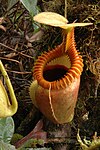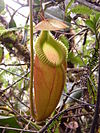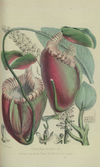Nepenthes villosa
| Nepenthes villosa | ||||||||||||
|---|---|---|---|---|---|---|---|---|---|---|---|---|

Nepenthes villosa |
||||||||||||
| Systematics | ||||||||||||
|
||||||||||||
| Scientific name | ||||||||||||
| Nepenthes villosa | ||||||||||||
| Hook.f. |
Nepenthes villosa is a carnivorous plant belonging to the genus pitcher plants ( Nepenthes ). It wasfirst describedby the botanist Joseph Dalton Hooker around 1860. The specific epithet villosa isborrowed fromthe Latin word “villosus”, which means “furry” and on the one hand alludes to the coarse hairs of the plant and on the other hand describes the fringed-looking peristome of the pitchers.
description
Nepenthes villosa is a perennial , evergreen subshrub that lives either terrestrially , lithophytically or epiphytically and is characterized by creeping or climbing lianas . The shoot axes can be up to 6 meters long. The plant lignifies with age and often sprouts young shoots from the wood. The leaves of Nepenthes villosa are broadly elliptical and sit alternately on the stem axis. They have a furry, hairy surface and form disproportionately long tendrils so that the pitchers can be placed on the ground.
The pitchers of Nepenthes villosa are drum-shaped and can be up to 36 centimeters tall. This makes them one of the largest traps in the Nepenthes genus . The peristome is very ribbed. The individual ribs protrude like claws at the inner edge of the peristome. The lid is spatula-shaped and is usually at a slight angle over the opening. The color of the pitchers depends on the light; in full sun they turn scarlet red, whereby the peristome is always clearly lighter and more intensely colored. In old age, rare air cans that are significantly slimmer can be formed.
Inflorescence and flowers
Like most of its relatives, Nepenthes villosa also develops paniculate inflorescences . The flowers are dioecious, separate sexes ( diocesan ), so a plant has either only male or only female flowers. The unisexual flowers have five bracts , which can be greenish or - in full sunlight - dark brown.
distribution
Nepenthes villosa can only be found in Borneo on the slopes of Mount Kinabalu at altitudes of 2400 to 3200 meters. There it grows in mossy forests or in open terrain with bush and grass vegetation on ultra-basic rock.
Botanical history
Nepenthes villosa was still equated with Nepenthes edwardsiana around 1895 , which was initially confirmed by Benedictus Hubertus Danser in 1928. The botanist John Muirhead Macfarlane, however, has always separated the two species.
The species is closely related to Nepenthes edwardsiana and Nepenthes macrophylla .
Endangerment status
Because of its complicated maintenance and its rarity, Nepenthes villosa is a sought-after collector's item. Together with the small extent of their natural areas, this has meant that Nepenthes villosa has to be protected by the Washington Convention on the Protection of Species (CITES) on Appendix II of the list of “threatened species”. Trading in this species is also prohibited.
Hybrids
Of Nepenthes villosa two natural hybrids are particularly famous: Nepenthes × harryana ( Nepenthes edwardsiana × Nepenthes villosa ) and Nepenthes × kinabaluensis ( Nepenthes rajah × Nepenthes villosa ).
literature
- Guido J. Braem: Carnivorous Plants. Species and culture. Naturbuch-Verlag, Augsburg 1992, ISBN 3-89440-014-5 .
Web links
Individual evidence
- ↑ Description of N. villosa (English and Latin .; very detailed)
- ^ A b c Matthew Jebb, Martin Cheek: A Skeletal Revision of Nepenthes (Nepenthaceae). In: Blumea. Vol. 42, 1997, ISSN 0006-5196 , pp. 1–106, here pp. 91–93, ( digital version (PDF; 8.82 MB) ).
- ↑ JD Hooker: On the origin and the development of the pitchers of Nepenthes, with an account of some new Bornean plants of that genus in: The Transactions of the Linnean Society of London 1859 ; 22nd edition; Page 415–424.
- ^ IUCN list


